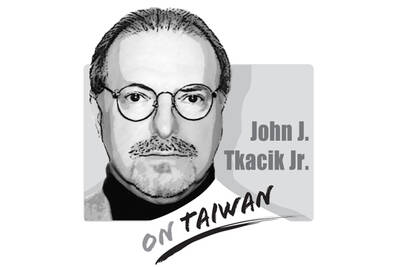As the Latin name of Taiwan’s premier academic institution, Academia Sinica, translates into “Chinese Academy,” some of its members are calling for a name change to avoid confusion, but media reports have said that all those being considered are English-language names.
While serving at the academy, my affiliation was always listed at the end of every research paper as “Institute of Mathematics, Academia Sinica.” The first half of the author affiliation was in English and the second half in Latin, a mix that really is neither fish nor fowl.
As not many of those in the academy’s institutes can translate the names of their institutes into Latin, it seems more convenient to translate the name of the academy into English.
Why was the academy’s name translated into Latin when it was established in 1928? The main reason was that Latin was the language of academia until the middle of the 19th century.
Great mathematicians, such as Carl Gauss and Georg Riemann, all wrote their papers in Latin.
Next, German became the dominant language in math, until World War II when its dominance was usurped by English — which shows that whichever language academia considers to be the international language is changeable.
Another reason the academy’s name was translated into Latin is that Latin was the common language of the ancient world.
Still, the status of international languages changes over time. French, which was the lingua franca until World War II, has been replaced by English — although French is still the language used for international exchanges on postal affairs.
Today, English is the world’s common language.
The UK used to be the “empire on which the sun never sets,” and the US has been a superpower since World War II. As the two nations have English in common, English has become today’s lingua franca, not without implying a certain hegemonic power.
During the Cold War era, countries in the Soviet Union used Russion as a common language, so, against this backdrop, the Latin translation of the academy’s name helped avoid hegemonic connotations, as Latin was by then a neutral language.
Unfortunately, the complexity of Latin grammar has led to its disuse, to the point that it has almost exclusively become the language of the Catholic Church, rendering inappropriate a Latinate name such as “Academia Taiwanica.”
In 1887, Polish ophthalmologist Ludwik Zamenhof created the language Esperanto, which he intended to be used as a universal lingua franca.
Esperanto is easy to learn, can be used for academic discussions, and is not the mother tongue of any country or people.
In the past few years, the number of Esperanto learners has sharply risen. Even the UN has used it. UNESCO published a book titled De ideoj al agoj, 70 jaroj de UNESKO to mark the organization’s 70th anniversary in 2015.
Esperanto has received little attention in Taiwan — fewer than 100 Taiwanese can speak it.
However, Wu Rwei-ren (吳叡人), an associate research fellow at Academia Sinica’s Institute of Taiwan History, is one of them.
Esperanto is a developing, democratic language. As the US is one of the world’s primary democracies, many Americans are learning Esperanto.
The academy should adopt a name in Esperanto, such as “Tajvana Akademio” or “Centra Esplora Akademia Tajvana.” It could even be renamed “Centra Esplora Akademio, Tajvano” to avoid conflict between the pan-blue and pan-green camps.
Wang Ju-kwei is a retired professor of National Central University’s Department of Mathematics.
Translated by Eddy Chang

On May 7, 1971, Henry Kissinger planned his first, ultra-secret mission to China and pondered whether it would be better to meet his Chinese interlocutors “in Pakistan where the Pakistanis would tape the meeting — or in China where the Chinese would do the taping.” After a flicker of thought, he decided to have the Chinese do all the tape recording, translating and transcribing. Fortuitously, historians have several thousand pages of verbatim texts of Dr. Kissinger’s negotiations with his Chinese counterparts. Paradoxically, behind the scenes, Chinese stenographers prepared verbatim English language typescripts faster than they could translate and type them
More than 30 years ago when I immigrated to the US, applied for citizenship and took the 100-question civics test, the one part of the naturalization process that left the deepest impression on me was one question on the N-400 form, which asked: “Have you ever been a member of, involved in or in any way associated with any communist or totalitarian party anywhere in the world?” Answering “yes” could lead to the rejection of your application. Some people might try their luck and lie, but if exposed, the consequences could be much worse — a person could be fined,
Xiaomi Corp founder Lei Jun (雷軍) on May 22 made a high-profile announcement, giving online viewers a sneak peek at the company’s first 3-nanometer mobile processor — the Xring O1 chip — and saying it is a breakthrough in China’s chip design history. Although Xiaomi might be capable of designing chips, it lacks the ability to manufacture them. No matter how beautifully planned the blueprints are, if they cannot be mass-produced, they are nothing more than drawings on paper. The truth is that China’s chipmaking efforts are still heavily reliant on the free world — particularly on Taiwan Semiconductor Manufacturing
Keelung Mayor George Hsieh (謝國樑) of the Chinese Nationalist Party (KMT) on Tuesday last week apologized over allegations that the former director of the city’s Civil Affairs Department had illegally accessed citizens’ data to assist the KMT in its campaign to recall Democratic Progressive Party (DPP) councilors. Given the public discontent with opposition lawmakers’ disruptive behavior in the legislature, passage of unconstitutional legislation and slashing of the central government’s budget, civic groups have launched a massive campaign to recall KMT lawmakers. The KMT has tried to fight back by initiating campaigns to recall DPP lawmakers, but the petition documents they